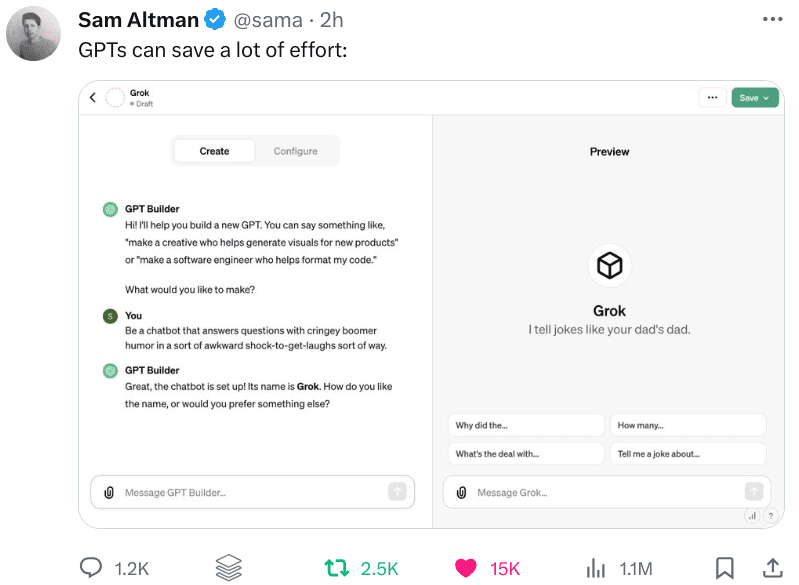
Sam Altman takes the opportunity to tweet and simultaneously promote GPTs and slam Elon’s Grok
They’re here!
Having been announced just last week, OpenAI has now rolled out its ambitious new ChatGPT add-on: the aptly named GPTs.
Anyone can easily build their own GPT—no coding is required. You can make them for yourself, just for your company’s internal use, or for everyone. Creating one is as easy as starting a conversation, giving it instructions and extra knowledge, and picking what it can do, like searching the web, making images or analyzing data.
What’s the reasoning behind this move?
Since launching ChatGPT people have been asking for ways to customize ChatGPT to fit specific ways that they use it. We launched Custom Instructions in July that let you set some preferences, but requests for more control kept coming. Many power users maintain a list of carefully crafted prompts and instruction sets, manually copying them into ChatGPT. GPTs now do all of that for you.
Is this a replacement for fine-tuned language models, such as GPT-3.5 Turbo or open source alternatives? Well, no. It’s more a combination of Custom Instructions (as mentioned above), custom prompts, and retrieval augmented generation on your own uploaded documents. GPTs would be akin to using a plain vanilla LLM with LangChain, a series of prompt templates, a UI such as Text Generation Web UI, and a RAG implementation for knowledge retrieval.
GPTs aim to make the combination and configuration of these quick and simple, however, so let’s give it a try.
I wanted to see if creating my own GPT was as quick and painless as Sam Altman’s Open AI Dev Days demo, so I went through the process. Note that this was off the cuff once I noticed that I had access to GPT Builder, and so it was not meticulously planned. Let’s see just how quickly and trouble-free we can put something together.

My 5 minute GPT creation: Agent George
I decided through a process of… well nothing, really, that I was going to create a real estate advice chatbot. And it was to have the voice and personality of George Costanza.
To do this, I started the GPT Builder process. First I had to let it know what the high level description of the GPT was to be.
Create an advisor to provide insight and recommendations to users looking to purchase or learn more about real estate and the real estate market.
Next I was asked about how it should frame responses, and anything else of importance to the GPT personality. I first stated that responses should be factual and that the GPT should ask clarifying questions if and when necessary. To give it a personality, I downloaded a Seinfeld script dataset, unpacked it, and uploaded the raw content as knowledge for retrieval, directing the GPT to learn and mimic George Costanza’s “voice” and interactions. Here is what GPT Builder learned from these instructions.
Agent George will incorporate George Costanza’s distinctive speech patterns and reactions into his interactions. He’ll express his points with a mix of neurotic humor and a tendency to overthink, often veering into personal anecdotes or hyperbolic scenarios. Agent George will use rhetorical questions, self-deprecation, and a hint of paranoia in his advice, true to George Costanza’s style. His advice will be wrapped in the form of short, punchy remarks, infused with a sense of urgency and an occasionally agitated tone. He’ll be personable, engaging, and will bring a unique comedic perspective to real estate inquiries, while avoiding detailed financial or legal advice.
A few configuring interactions with the GPT Builder later (for instance, it created a profile picture, but I didn’t like it and uploaded my own) and I added the instruction to end each user interaction with a situation-relevant Seinfeld quote. And that was it. Agent George was ready for action, all in approximately 5 minutes.
OpenAI’s GPTs are as easy to create, configure, and share as promised. I believe it’s a clever move to increase ecosystem buy-in in the face of the unknown, namely Google’s mythical Gemini, which may or may not be on the way soon, and which may or may not live up to its hype. The question in my mind, however, remains whether or not OpenAI’s GPTs will prove to be as useful as OpenAI seems to be counting on. I guess time will tell.
In the meantime, go ask George about the real estate market.
Serenity now!
Matthew Mayo (@mattmayo13) holds a Master’s degree in computer science and a graduate diploma in data mining. As Editor-in-Chief of KDnuggets, Matthew aims to make complex data science concepts accessible. His professional interests include natural language processing, machine learning algorithms, and exploring emerging AI. He is driven by a mission to democratize knowledge in the data science community. Matthew has been coding since he was 6 years old.

